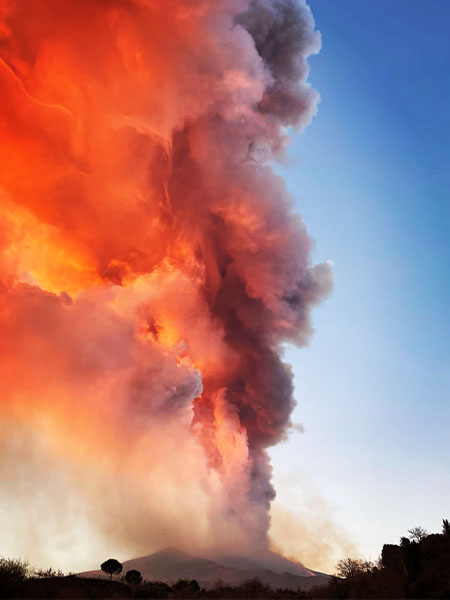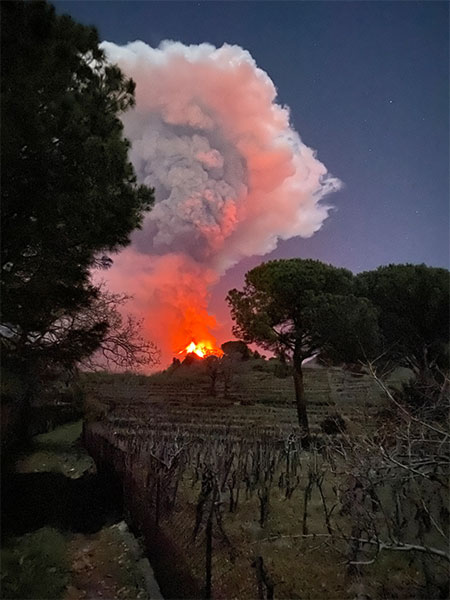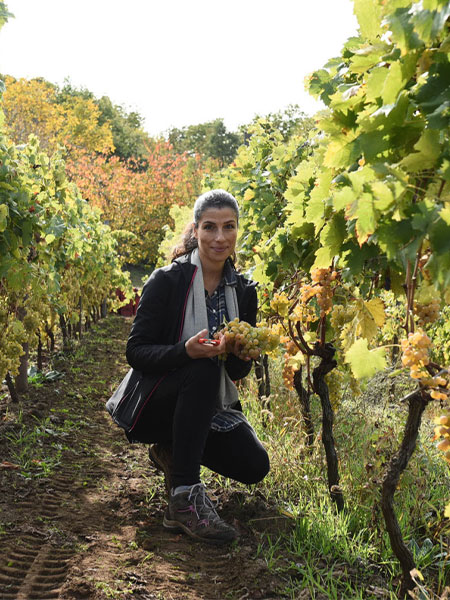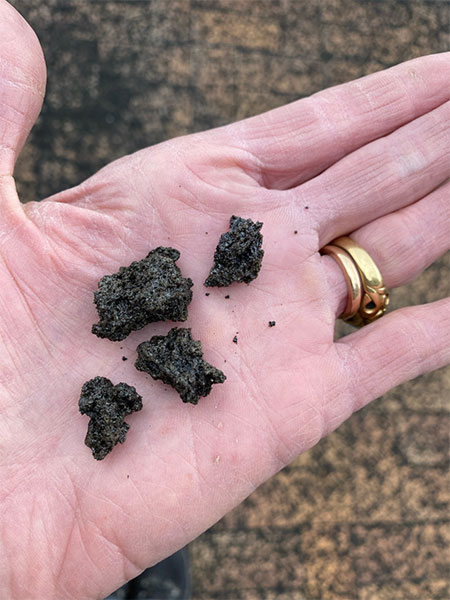Living on the slopes of Sicily’s Mount Etna has its pros and cons. Etna is Europe’s most active volcano, keeping inhabitants on edge, yet it is also the source of some of Italy’s most singular and delicious wines. Locals say they get used to the activity, but once in a while Etna sends up a reminder of the power that lies beneath its slopes. Volcanic activity began intensifying in mid-February, leading to some spectacular discharges of ash and debris, with additional eruptions on February 24.


Photo by Ciro Biondi
“The southeastern crater of Etna has by far been the most active one in recent decades,” says Antonio Benanti, president of the Etna consorzio and co-proprietor of his family’s eponymous winery in Viagrande, on the mountain’s southeastern slope. “Just before the [initial] eruption took place, we had a few very cold days and it had snowed on many vineyards on all slopes of Etna. So we went from one extreme to the other, first the snow, then the lava.”


Photo by Stef Biondi
“We had several hours of constant falls of ashes and stones, like a proper rain,” said Sonia Spadaro Mulone, proprietor of Santa Maria La Nave. Her vineyard rises up more than 2,600 feet above sea level on Etna’s southeastern slope, where winds carried much of the ash that fell from the eruptions. “The stones are light, like biscuits, so they do not damage the vines, especially in this season, and all this volcanic material is very rich in minerals. I consider it a real blessing: free organic fertilizer!”




Photo by Stef Biondi
The Biondi estate, also on Etna’s southern flank, reported similar activity. “It’s quite magnificent to see and hear the power, but comforting to know that it’s usually quite a short performance. However, this eruption seems to be going on for longer,” said Stef Biondi, co-proprietor with her husband, Ciro Biondi. The Biondis are mostly concerned about the tremors that can follow an eruption, such as those that occurred on Christmas Eve in 2018.
Fortunately, that hasn’t happened this time—at least, not yet—but Spadaro Mulone has experienced the fallout from such tremors. “Three years ago, an earthquake partially destroyed my 400-year-old winery, and only now I have almost finished the restoration,” she says. “Even if we are used to these violent phenomena, the edge between a spectacular event and a tragedy is very thin. But if you live, work and breathe on an active volcano, this is part of the game.”
Winds pushed the cloud toward the mountain’s southeastern slopes. Here’s the sound of the debris raining down onto the Biondis’ vineyard
A Perspective on the Latest Eruptions


Photo by Valerie Quintanilla
American-born Benjamin Spencer has been living on Etna’s slopes since 2012. A wine maker and wine educator, he founded the Etna Wine School, and last year published The New Wines of Mount Etna. Spencer answered our questions about the latest eruptions of the volcano, and their impact of on the region’s viticulture. —Stephanie Johnson
How would you characterize the size or degree of Etna’s eruptions in February 2021?
Over the last few weeks, we’ve seen increased activity coming from the central craters. Imagine spontaneous, low-grade tremors and a fiery star of lava at the very top of the mountain every evening for a couple of weeks, followed by a few substantial tremors and a combination of gas, magma and ash being thrown out of Etna over several hours only to return to subtle paroxysms and ash emissions over the following days. It wasn’t the 2013 eruption which lasted six weeks or the 2015 eruption that created a lightning storm of colliding ash over the mountain. Nor was it the Christmas Eve 2018 eruption which included an earthquake that leveled buildings, displaced families, and closed businesses. No, this February 2021 eruption was a good one. It was short, expressive, beautiful, and awe-inspiring.
Did the ash and debris from the recent eruptions affect one part of the mountain more than others?
The eruption did seem to catch an east-by-southeast wind, so any ash that was emitted over the last week was deposited on the southeast and east slopes of Etna. That said, an incredible amount of effusive lava was deposited into and captured by the Valle del Bove, a massive extinct crater high on the volcano’s east slope.
What, if anything, was happening in the vineyards when these eruptions occurred?
Most of the vines have been winter-pruned; there is no new growth (buds, new shoots) until about mid-March. The cinders and flakes of pumice that fall to the ground during a volcanic emission event are typically adopted into the soil. On average, about 1,500 pounds of ash fall on Etna’s eastern slope over the course of one year. Light dustings of less than 0.1 centimeter begin adding beneficial nutrients to the soil in a matter of weeks. This eruption deposited a bit of fresh soil (silica sand and small stones) and stopped— another reason it was good. Deeper deposits from stronger eruptions can asphyxiate the roots of the vines
For those areas most affected, how do these new layers of ash and stone impact the upcoming growing season?
The eruption could not have come at a better time. The spring rains are starting. Ash and small stones add porosity to the soil, so the water can dive deep into the subsoil. Etna vines are dry farmed (irrigation is not allowed), so the vines depend on any water that arrives naturally. The vineyard floor vegetation benefits from the nutrient-rich ash and is subsequently tilled into the volcanic soil to feed the roots of the vines. Of particular importance is nitrogen, which comes from the green material of that vegetation. Volcanic soil is nitrogen-poor. Therefore, ash feeds the plants that feed the vines with the nitrogen they need to grow green shoots, leaves and tendrils in the spring.
How do the growers on Mount Etna view these types of eruptions?
I don’t like to put words in anyone’s mouth, but…my feeling is that safe and benevolent eruptions like this are welcomed. Not only do these events confirm what a spectacular thing it is to make wine (at all) on the largest active volcano in Europe, they pose the question: what is it about these particular wines that makes the risk meaningful? The awe we experience here, during an Etna eruption, is probably very similar to the awe you experience in scrolling through photo after photo of Etna’s recent eruption on the news or social media. It’s far better than TV for those who live here, because it’s a real slice of life. I, myself, soak in the moment. It’s an opportunity to witness a geologic event that sculpted a mountain. How many of us can say we saw, or lived through, something like that?
is the Italian wine editor at Wine & Spirits magazine.
This is a W&S web exclusive. Get access to all of our feature stories by signing up today.
















